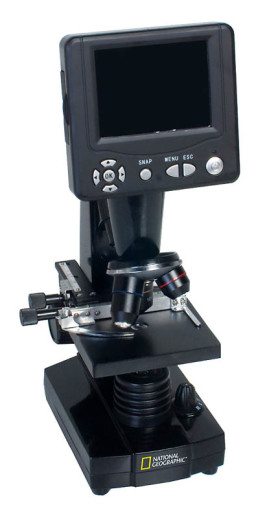We use cookies to make your experience better. To comply with the new e-Privacy directive, we need to ask for your consent to set the cookies. Learn more.
National Geographic LCD Microscope
Microscopes reveal a whole world of science not seen by the naked eye. The National Geographic LCD Microscope offers easier viewing with a 2 1/4"x 2 7/8" screen rather than an eyepiece - better for group viewing, younger children, and those with vision problems. Included with the microscope is a dust cover, 5 prepared slides and 10 blank slides (glass) with covers, Mikrotom tissue chopper, USB cable, power supply plug, scissors, pipette, tweezers, teasing needles, shrimp breeding container, sea salt, brine shrimp eggs, yeast, and gum media. All of this comes neatly organized in a nylon carrying case with handle and shoulder strap. The included instruction manual explains every part of the microscope and how to use it, along with instructions for 3 activities - including growing brine shrimp. The mechanical stage allows for easy focusing and the specimens can be viewed from 40X to 1600X with clarity. SD card required for photos, but not included.
When my daughter was in 4th grade, we bought her a Tasco Big Screen Microscope. She used that microscope for her first science fair and raised brine shrimp - this product brought back memories, but with big improvements. The instruction guide lists all parts of the microscope and items included in a numbered diagram and list - be sure to read through this to get familiar with the terms. Numbered steps with explanations help you get started and include number references for the diagram. This microscope has three light (LED) settings: bottom lighting to view slides and other transparent objects, top lighting to view opaque or solid objects that only works with the 4X objective, and top and bottom lighting at the same time for semi-transparent objects. Set-up is easy. Magnification is greater and clearer. There are 3 objectives (4X, 10X, 40X) and the LCD magnification factor is 12.5X. In combination, you will get magnifications of 40X, 125X, and 500X. A 6-position color filter disc rotates below the stage that can be used to help control the bright light to clarify the image and the up and down buttons below the screen can adjust the brightness of the image. An additional light collector lens is included that allows even more light for viewing, and a dimmer switch also lets you control the brightness. Increase the magnification even more by using the right and left controls below the screen, allowing you to increase the magnification up to 2000X!!
You can snap photos or record videos of your images and save them on an SD card (not included). Switch from the view of your live image to those saved on your SD card by using the "escape' button. Attach the USB cable to transfer the data to your computer for editing and printing.
Overall, I had a lot of fun playing with this microscope. I am totally amazed at the quality of the view and the ease of operation. The key is to read (completely) the user/instruction guide without skipping things. I read through several times before I realized all the capabilities of this scope. The National Geographic LCD Microscope could be used at the elementary level and up through high school. The magnification and clarity are the quality you would need for high school labs. My how technology has improved! ~ Donna
Take your quest for discovery to a cellular level with this high-end digital microscope from National Geographic. Offering an impressive magnification range of 40x to 1600x, this scope uses a 3.5" high-resolution LCD screen as an eyepiece to provide crisp, colorful specimen views that can be simultaneously shared by multiple users. To document your investigations, the instrument has a 2-megapixel camera that can take photos or videos for later analysis and includes effect options such as sepia or black and white. A smooth focusing wheel that works in conjunction with an advanced system that secures the slide and slowly glides it around the viewing stage produces detail-rich images with minimal refocusing. Other features include a versatile LED illumination system, a six-position color filter wheel, a USB cable for data transfer, internal storage memory, an SD card slot, collection tools, slides and a sturdy carrying case.
Review and compare microscopes sold at Rainbow Resource Center with our helpful Microscope Comparison Charts for: Grades K-8 and for Grades 6-12. Each microscope on the charts has an item number that links back to our website for a detailed description.
| Product Format: | Other |
|---|---|
| Brand: | Explore Scientific |
| Grades: | 3-AD |
| EAN/UPC: | 812257013135 |
| Length in Inches: | 15.375 |
| Width in Inches: | 8.75 |
| Height in Inches: | 7.25 |
| Weight in Pounds: | 6.4 |

